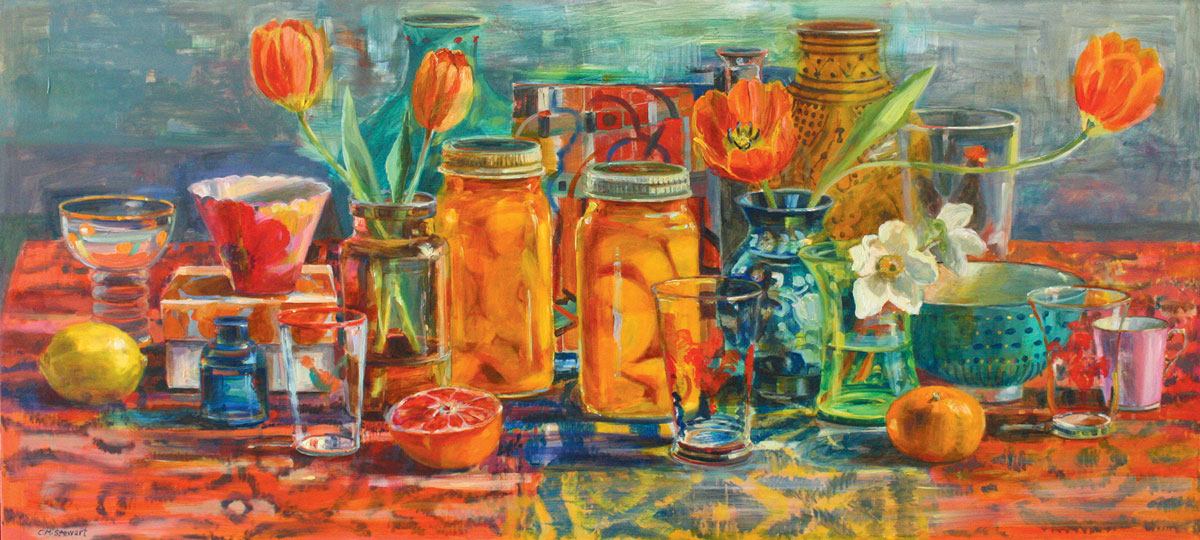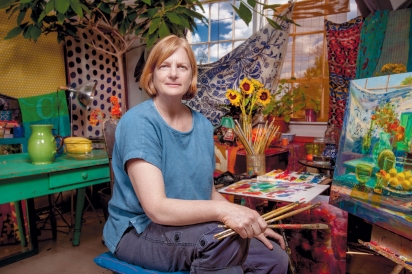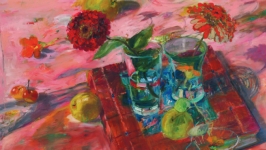A Living Art with Painter Carol Stewart
The late paintings of the French post-impressionist painter Pierre Bonnard (1867–1947) are some of his most masterful works. And yet Pablo Picasso, steeped in his Modernist perspective of art, decried Bonnard as out of touch with painting, claiming there were too many colors, too much indecision in the works, stating: “Painting isn’t a question of sensibility; it’s a matter of seizing the power, taking over from nature, not expecting her to supply you with information and good advice.”1
Stepping into local painter Carol Stewart’s art studio at Milo Arts Center feels like stepping into the threads of a late Bonnard painting. Nature and a rainbow sensibility are front and center in her still lifes. Carol paints what is alive; it’s clear. And Picasso would probably have none of it, for Carol is looking to the flowers, herbs, fruits and sunlight for information and beautiful advice. And she finds it.
Originally from Ontario, Canada, Carol moved from St. Louis, Missouri, to Columbus in 2012, and she made sure she had a studio space rented with ample natural light for her work before she even knew where she and her husband, Paul Goodfellow, were going to live. She chose Milo Arts Center, partially because her studio gets a good southern glow through the tall glass windows.
“I love observing the light falling on objects,” she says.
When I visited her studio, two different compositions were set up for still lifes in process. Carol has multiple paintings on the stove at a time, working between compositions to find the right alignment for each. Yellow tulips splayed their petals broadly towards a puddle of cool blue light while maturing lemons rested in a shallow glass bowl and one sunny pansy drooped over the red lip of a small glass of water. A plethora of flowers and fabric graced the whole room from corner to corner while paintings lined the one free white wall. Carol pointed to a rendition of a melon the color of a forest from the Milo community garden that she painted last year, telling me a whole story about the melon. For Carol, objects embody some essence worth noting.
“I need to feel a connection to the still life elements and their relationships,” she tells me when I ask why she paints from life and not from photographs. “When I feel an intensity and spark of inspiration looking at the still life, then I know it is time to proceed with the painting. I can rearrange or add things as I go. Every painting has to include some living elements—fruit or flowers. They seem to give the painting life.”
Representational artists are not boldly recognized by the mainstream contemporary art world. Carol’s affinity for what is seasonal and alive from gardens and local and faraway farms—lilies, kumquats her friend sent her one season, oranges, tomatoes (whole and sliced, red and yellow), eggplants, patty pan squash, nasturtiums, zinnias, cosmos, morning glory, dahlias— are not the subjects of most of the paintings at the Museum of Modern Art in New York City.
Carol studied painting techniques and earned her Master of Fine Arts at Fontbonne University in St. Louis with Chinese painter Victor Wang. She was drawn to the rigor required in the craft of realistic painting, and found energy for a long while painting more landscape-oriented works of her garden. She longed for a certain clarity, though, that she couldn’t find in her garden-scapes, and so began experimenting with still lifes for the chemistry of order and lushness found in a smaller subject matter. When she moved to Columbus she found the longstanding Hammond Harkins Galleries to represent her work along with the other galleries that represent her work around the world.
And while she gathers inspiration where most artists do among museums, books, from other painters like Richard Diebenkorn of the Bay Area Figurative Movement and the Italian Baroque painter Giovanna Garzoni, and even Facebook where she connects with other likeminded artists from around the world, it’s what she grows in her garden and what other people grow and give to her that lies at the heart of her expert eye.
“My art is intertwined with my life,” she says. “I paint the things around me and I choose the things I surround myself with. I see a bowl of lemons on the counter in our kitchen and off it goes to the studio. I see interesting vegetables, fruit or flowers when grocery shopping and my art gives me an excuse to buy them. We grow a tomato and then I eat it, or I paint it or both!”
We here in Central Ohio are the lucky recipients of her hunger for life, for Carol and her husband, Paul, frequent the North Market and Bexley farmers markets, the Bexley Natural Market and local florists. What the farmers and growers bring to the market might be what lands in Carol’s compositions.
“Food is a big part of our life,” she says. “We like to cook together and make fresh healthy food— simple and straightforward. We love to break bread with family and friends. People love to come to our house for a fun meal and to talk about art among other things—we love to eat outside in the garden.”
This summer Carol is growing several types of herbs, including thyme, marjoram, fennel, lovage, oregano, basil, tarragon, mint, sorrel and sage, fresh greens and tomatoes, peas and eggplants, along with several different varieties of flowers. When she’s not in her studio, keeping a rigorous schedule of painting every day, she’s most likely in her garden, or outside somewhere planting flowers in a garden pot.
“I grow things for my painting, for eating and just for fun and pleasure and to share,” she says. “Nurturing and growing things is infinitely satisfying. It is my way to feel connected to the Earth.”
Carol’s paintings suggest a peaceful place where the more quotidienne and lovable aspects of the natural world are tended and presented for whomever stops to look. Her work evokes a settled play. As she writes, “My still life paintings are not still.”
It’s art work reminiscent of those most ephemeral moments when we’re out in the world and know we are alive because we see, taste, smell, feel for one moment something from the garden, farm or forest floor that is alive, too. And together we meet in our aliveness. And together we dance.
Learn more about Carol Stewart and her paintings here or visit Hammond Harkins Gallery in Columbus.
1 Amory, Dita. Pierre Bonnard: The Late Still Lifes and Interiors. The Metropolitan Museum of Art, 2009.






